
The King's Royal Rifle Corps was an infantry rifle regiment of the British Army that was originally raised in British North America as the Royal American Regiment during the phase of the Seven Years' War in North America known in the United States as 'The French and Indian War.' Subsequently numbered the 60th Regiment of Foot, the regiment served for more than 200 years throughout the British Empire. In 1958, the regiment joined the Oxfordshire and Buckinghamshire Light Infantry and the Rifle Brigade in the Green Jackets Brigade and in 1966 the three regiments were formally amalgamated to become the Royal Green Jackets. The KRRC became the 2nd Battalion, Royal Green Jackets. On the disbandment of the 1st Battalion, Royal Green Jackets in 1992, the RGJ's KRRC battalion was redesignated as the 1st Battalion, Royal Green Jackets, eventually becoming 2nd Battalion, The Rifles in 2007.

The Infantry of the British Army, part of the structure of the British Army, comprises 49 infantry battalions, from 19 regiments. Of these, 33 battalions are part of the Regular army and the remaining 16 a part of the Army Reserve. The British Army's Infantry forms a highly flexible organisation, taking on a variety of roles, including armoured, mechanised, air assault and light.

The Royal Gloucestershire, Berkshire and Wiltshire Regiment was a short-lived infantry regiment of the British Army.
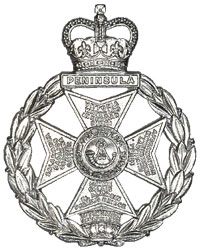
The Royal Green Jackets (RGJ) was an infantry regiment of the British Army, one of two "large regiments" within the Light Division.

The Light Infantry was an infantry regiment of the British Army, part of the Light Division. The regiment was one of four 'large' regiments formed after the 1966 Defence White Paper through the amalgamation of units of the Light Infantry Brigade. Originally consisting of four battalions, it was later reduced to three battalions, and finally amalgamated into The Rifles with just two battalions which became the 5th and 3rd Battalions respectively.
The Rifle Volunteers was a regiment of the British Territorial Army. In 2007, it was re-designated as 6th Battalion, The Rifles.

The Devonshire and Dorset Regiment, usually just known as the Devon and Dorsets, was an infantry regiment of the British Army formed in 1958 by the amalgamation of two county regiments, the Devonshire Regiment and the Dorset Regiment. In 2007 it was itself merged into The Rifles, a "large regiment".
The Rifles is an infantry regiment of the British Army. Formed in 2007, it consists of five Regular and three Reserve battalions, plus a number of companies in other Army Reserve battalions. Each battalion of The Rifles was formerly an individual battalion of one of the two large regiments of the Light Division. Since formation the regiment has been involved in combat operations, first in the later stages of the Iraq War and in the War in Afghanistan.

The 52nd Lowland Volunteers is a battalion in the British Army's Army Reserve or reserve force in the Scottish Lowlands, forming the 6th Battalion of the Royal Regiment of Scotland, also known as 6 SCOTS. Due to its erstwhile association with the 1st Regiment of Foot, it is the senior Reserve line infantry battalion in the British Army. It is one of two Reserve battalions in the Royal Regiment of Scotland, along with 51st Highland, a similar unit located in the Scottish Highlands.

The South African Army Infantry Formation supervises all infantry within the South African Army.
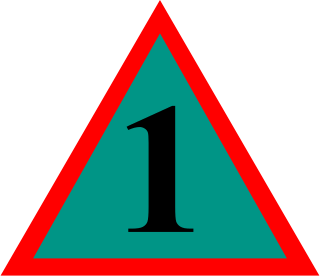
The 1st Armoured Infantry Brigade is an infantry brigade of the British Army with a long history including service during both World War I and World War II. It is based at Tidworth Camp. Previously, it has been designated 1st (Guards) Brigade, 1st Infantry Brigade, 1st Mechanised Brigade, and under the initial Army 2020 reforms assumed the title of 1st Armoured Infantry Brigade.

A rifle regiment is a military unit consisting of a regiment of infantry troops armed with rifles and known as riflemen. While all infantry units in modern armies are typically armed with rifled weapons the term is still used to denote regiments that follow the distinct traditions that differentiated them from other infantry units.
The Wessex Regiment was a Territorial Army (TA) infantry regiment of the British Army between 1971 and 1995. It had two battalions: The 1st Bn with its headquarters at Le Marchant Barracks in Devizes and the 2nd Bn (Volunteers), which was headquartered at Brock Barracks in Reading. In 1994, the battalions were amalgamated to form the 2nd Bn the Royal Gloucestershire, Berkshire and Wiltshire Regiment, later the Royal Rifle Volunteers.
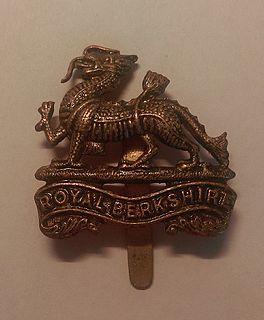
The Royal Berkshire Regiment was a line infantry regiment of the British Army in existence from 1881 until 1959. The regiment was created in 1881, as the Princess Charlotte of Wales's , by the amalgamation of the 49th (Hertfordshire) Regiment of Foot and the 66th (Berkshire) Regiment of Foot. In 1921, it was renamed the Royal Berkshire Regiment .

Bulford Camp is a military camp on Salisbury Plain in Wiltshire, England. Established in 1897, the site continues in use as a large British Army base. The camp is close to the village of Bulford and is about 2 1⁄4 miles (3.6 km) northeast of the town of Amesbury. The camp forms part of the Tidworth, Netheravon and Bulford (TidNBul) Garrison.
A large regiment is a multi-battalion infantry formation of the British Army. First formed in the 1960s, large regiments are the result of the amalgamation of three or more existing single-battalion regiments, and perpetuate the traditions of each of the predecessor units.
In September 1939, the British Army was in process of expanding their anti-aircraft and mobile assets. Among these new changes was the formation of Anti-Aircraft Command which was formed on 1 April 1939, and the 1st Armoured Division formed in 1937. The list below will include the British Army units, colonial units, and those units which were in the process of formation.
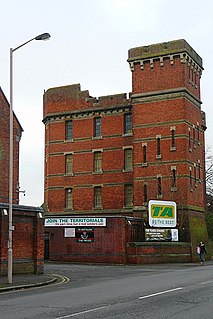
Brock Barracks is a British Army barracks in the town of Reading in the English county of Berkshire. Located on Oxford Road in the district of West Reading. The majority of the buildings and structures within Brock Barracks are Grade II listed.
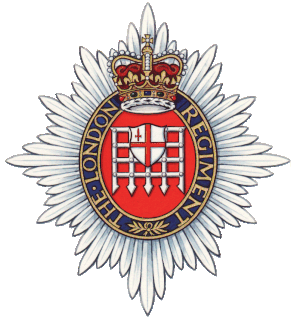
The London Regiment is an infantry regiment in the Army Reserve of the British Army. It was raised in 1993, perpetuating the lineage of some but not all the battalions of an earlier regiment of the same name. The London Regiment is the only reserve infantry battalion of the Guards Division as well as being the only reserve infantry battalion completely in London District.














